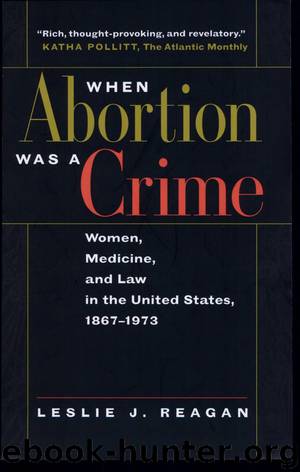When abortion was a crime by Leslie J. Reagan

Author:Leslie J. Reagan
Language: eng
Format: epub
Publisher: University of California Press
Pearse and Ott detailed the review process of one of the earliest therapeutic abortion committees. Although designed to bring conformity to medical practice in the hospital, the committee nonetheless ran into controversy. In 1940, Florence Crittenton had created a committee of three obstetrician-gynecologists to decide whether or not to allow therapeutic abortions. A physician who wanted approval for a therapeutic abortion submitted a letter to the committee along with the medical indications for the procedure and the recommendations of consultants. The committee then circulated the request among its members. The chairman reviewed the comments and met with members if there were disagreements. If the committee approved a request, the request and the letter of approval were included in the patient's permanent medical record. In 1946, in response to a rise in the number of sterilization procedures, the committee was given the additional task of approving or vetoing sterilizations, a move suggesting that physicians were again listening to patients who wanted to end their childbearing. The following year the committee had to be reorganized into an anonymous committee in order to put a stop to the pleas and complaints being directed at the head of the department whenever a request was denied.73
The new structure regulating therapeutic abortions in the hospital limited their number while preserving a small area in which some specialists could still practice legal abortion. Therapeutic abortion committees helped take legal abortion out of the hands of general practitioners and private, nonhospital-based practice and place it in the control of hospital-based specialists in obstetrics. Hospital abortion committees, generally composed of specialists in obstetrics and chiefs of hospital divisions, regulated the medical practice of their colleagues and were particularly concerned about the practices of general practitioners. As these specialists checked the abortion practices of general practitioners, they protected their own right to do therapeutic abortions. Obstetricians regarded themselves, researchers observed, "vis-avis the general practitioner, the guardians of standards of practice in this area."74 Family doctors, because of their knowledge of an entire family and its problems, may have been more likely to consider the whole situation of a woman, rather than sticking to rigidly defined medical indications.75 The tradition of listening to a patient's story and taking her whole life situation into consideration when reaching medical decisions was being delegitimated. The requirement that physicians obtain the approval of their peers (or superiors) through the committee system changed the relationship between women and their doctors.
Download
This site does not store any files on its server. We only index and link to content provided by other sites. Please contact the content providers to delete copyright contents if any and email us, we'll remove relevant links or contents immediately.
Good by S. Walden(3514)
The Social Psychology of Inequality by Unknown(2985)
0041152001443424520 .pdf by Unknown(2810)
The Checklist Manifesto by Atul Gawande(2806)
The Meaning of the Library by unknow(2529)
Get What's Yours for Medicare: Maximize Your Coverage, Minimize Your Costs by Philip Moeller(2343)
Guns, Germs and Steel by Diamond Jared(2332)
Borders by unknow(2278)
23:27 by H. L. Roberts(2221)
And the Band Played On by Randy Shilts(2162)
Being Mortal: Medicine and What Matters in the End by Atul Gawande(2091)
A Leg to Stand On by Oliver Sacks(2020)
The Hot Zone by Richard Preston(1994)
More Than Words (Sweet Lady Kisses) by Helen West(1833)
The Valachi Papers by Peter Maas(1829)
The Laws of Medicine by Siddhartha Mukherjee(1769)
The Andromeda Strain by Michael Crichton(1717)
The Obesity Epidemic by Robyn Toomath(1653)
Pharmacy Practice and The Law by Richard Abood(1555)
